
The House of Gabrielli (sometimes known as "Gabrielli di Gubbio") is the name of an old and influential feudal Italian noble family from Gubbio, a town in Umbria.

The House of Gabrielli (sometimes known as "Gabrielli di Gubbio") is the name of an old and influential feudal Italian noble family from Gubbio, a town in Umbria.
Some historians trace their origins back to the Roman age and claim they descend from the emperor Caracalla, however the first historical documents mentioning the family appear in the 10th century only when Cante Gabrielli was awarded by Pope Stephen VII (according to some genealogists a family member himself), a few castles in central Italy and especially the castle at Luceoli which was renamed Cantiano (i.e. belonging to Cante) after him.


The family divided over the centuries in many branches, the most famous of which was the one that settled in Rome and obtained the title of Prince of Prossedi. Two members of this branch married two princesses of the Bonaparte family. In 1749 the counts of Carpegna extinguished in the male line and the marquesses Gabrielli inherited their fief, with the principality of Carpegna-Gattara-Scavolino following in 1817. The line is currently continuing in the family of the princes di Carpegna-Falconieri-Gabrielli.
A branch that settled in Fano was styled Gabrielli-Wiseman, and was related to Cardinal Nicholas Wiseman. Another branch settled in Fano was styled Gabrielli di Montevecchio, and bears the titles of Duke and Count. The branch that settled in the Kingdom of the Two Sicilies bears the title of Count Gabrielli and Baron of Quercita.
A branch bears the title of Count of Baccaresca and Corraduccio since 1581. It settled in Comtat Venaissin at the end of the 16th century when Bartolomeo de' Gabrielli di Gubbio became Governor of Cavaillon then Carpentras. The line is continuing today in France.
All the branches bear the title of Patrizio di Gubbio (Patrician of Gubbio).
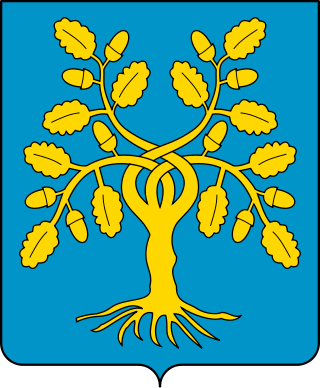
The House of Della Rovere was a powerful Italian noble family. It had humble origins in Savona, in Liguria, and acquired power and influence through nepotism and ambitious marriages arranged by two Della Rovere popes: Francesco Della Rovere, who ruled as Sixtus IV from 1471 to 1484) and his nephew Giuliano, who became Julius II in 1503. Sixtus IV built the Sistine Chapel, which is named for him. Julius II was patron to Michelangelo, Raphael and many other Renaissance artists and started the modern rebuilt of St. Peter's Basilica. Also the Basilica of San Pietro in Vincoli in Rome was the family church of the Della Rovere. Members of the family were influential in the Church of Rome, and as dukes of Urbino, dukes of Sora and lords of Senigallia; the title of Urbino was extinguished with the death of Francesco Maria II in 1631, and the family died out with the death of his granddaughter Vittoria, Grand Duchess of Tuscany.
Pope Stephen VII was the bishop of Rome and nominal ruler of the Papal States from February 929 to his death in 931. A candidate of the infamous Marozia, his pontificate occurred during the period known as the Saeculum obscurum.
Federico II Paolo Novello da Montefeltro was the reigning Count of Urbino from 1364 until his death.

The House of Montefeltro is the name of a historical Italian family who ruled Urbino and Gubbio and became Dukes of Urbino in 1443. The family extinguished in the male line in 1508 and the duchy was inherited by the Della Rovere family.

Gubbio is an Italian town and comune in the far northeastern part of the Italian province of Perugia (Umbria). It is located on the lowest slope of Mt. Ingino, a small mountain of the Apennines.

The House of Malatesta was an Italian family that ruled over Rimini from 1295 until 1500, as well as other lands and towns in Romagna and holding high positions in the government of cities in present-day Tuscany, Lombardy and Marche. The dynasty is considered among the most important and influential of the Late Middle Ages. In the period of maximum influence, they extended their domains along the Marche coast, up to Ascoli Piceno, Senigallia, Sansepolcro and Citerna, and to the north, on the territories of Bergamo and Brescia.

Carpegna is a comune (municipality) in the Province of Pesaro e Urbino in the Italian region Marche, located about 100 kilometres (62 mi) west of Ancona and about 50 kilometres (31 mi) southwest of Pesaro.

The Simonetti family is an Italian noble family with origins in Tuscany. During the 12th century different branches in Florence, Terni, Lucca, Pistoia and Pescia developed. Other famous branches of this family were established in Jesi, Palermo, Milan and Bologna.
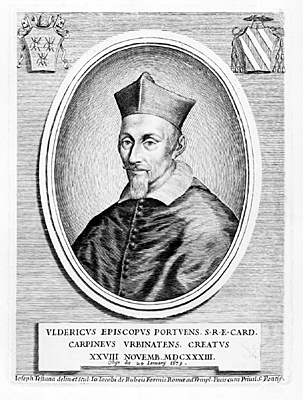
Ulderico Carpegna was an Italian jurist and Cardinal.

The Diocese of Gubbio is a Latin diocese of the Catholic Church in the province of Perugia, in Umbria, central Italy.
Gabrielli is a surname originating in Italy. Due to Italian diaspora, it is also common in other countries such as the United States, Brazil, Argentina, Uruguay, Chile and France. The surname Gabrielli derives from the given name Gabriello and it means "son of Gabriello".
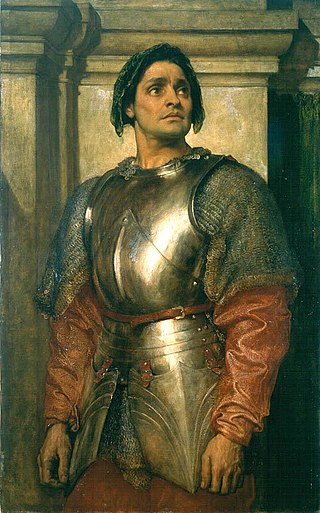
Cante dei Gabrielli di Gubbio was an Italian nobleman and condottiero.
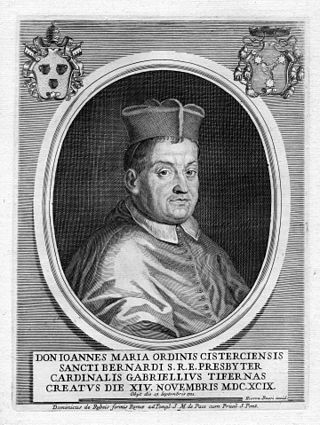
Giovanni Maria Gabrielli was an Italian Catholic Church's cardinal.
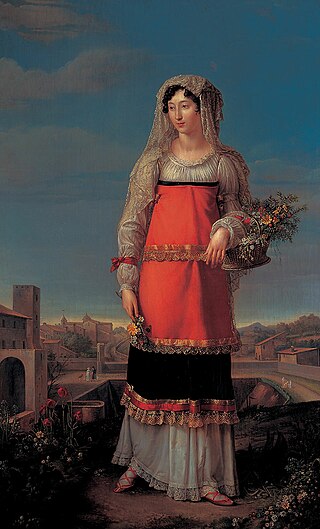
Filistine Charlotte Bonaparte Gabrielli was a French Napoleonic princess and the eldest daughter of Lucien Bonaparte and Christine Boyer. She became princess Gabrielli following her marriage to Mario Gabrielli, prince of Prossedi and Roccasecca, Duke of Pisterzo. In Italy, she was known as Carlotta.
Gabriele de' Gabrielli (1445–1511) was an Italian Roman Catholic bishop and cardinal.
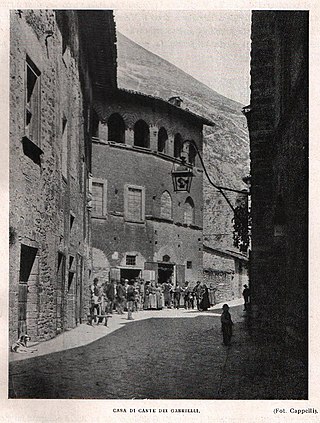
The Palazzo del Capitano del Popolo or Palazzo di Cante Gabrielli is a medieval palace in Gubbio, Italy. It is located in the San Martino's quartiere, near Porta Metauro, at the corner of via Gabrielli and via Capitano del Popolo.
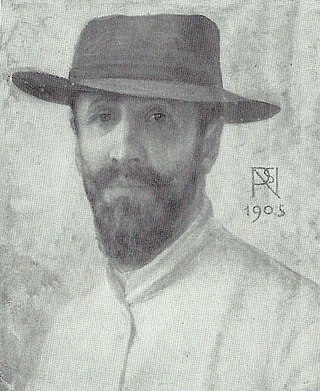
Napoleone Parisani was an Italian landscape and occasional portrait painter.

The Castle of Carbonana is a medieval fortress located on a promontory overlooking the state road 219 that links Gubbio to Umbertide in the region of Umbria, Italy.

Augusta Amélie Maximilienne Jacqueline Bonaparte was a French-Italian Napoleonic princess.
Carpegna is an Italian surname. Notable people with this name include the following: